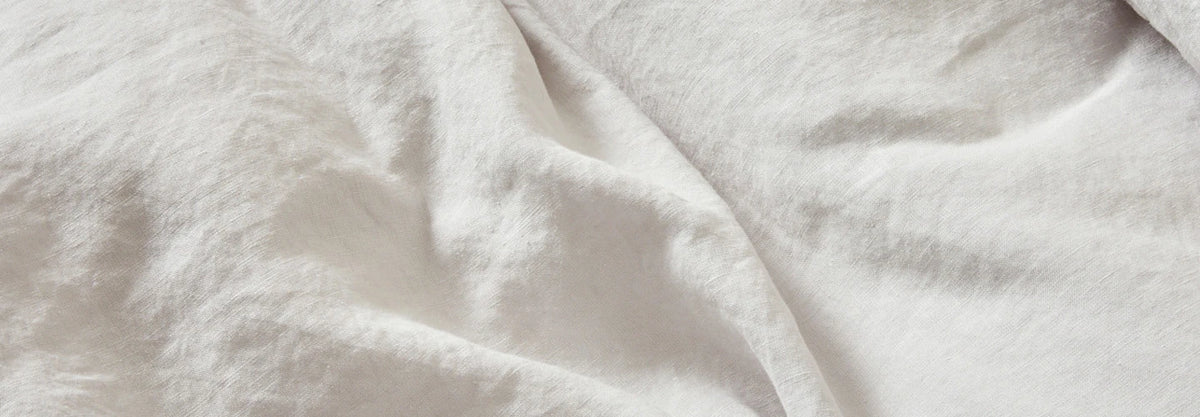
Debunking Bamboo + Eucalyptus
•
Cayla Zelanis
Natural, organic fibers are at the heart of every Coyuchi piece — but organic is only the beginning. With exciting new “green” textiles touting bamboo and eucalyptus fibers hitting the market, why aren’t we seeing them on Coyuchi’s shelves? The truth is, not all “natural” fibers are created — or processed — equal, and the possibility of sustainable bamboo and eucalyptus bedding, more often than not, might just be too good to be true.
Let's break down the pros and cons of each fabric, and explain why we choose to stick with organic cotton and linen.

Bamboo
Pros
As a plant, bamboo is fast-growing and fantastically sustainable, improving soil quality, producing more wood per acre than most standard trees, storing four times more CO2, and releasing 35% more oxygen. As far as farming is concerned, bamboo checks all of the environmentally conscious boxes.
Cons
As a fabric, bamboo’s benefits can get a little murky. While organic, sustainably made bamboo fiber does exist, much of the “green” labeling of these textiles does not take the processing into account. Dyes containing lead, mercury, or other heavy metals, mutagenic chemicals, and endocrine disruptors are commonly used in the manufacturing process — causing harm to not only the consumer, but the workers in these factories, and the waterways that receive the untreated effluent afterwards.
There is still no organic certification for bamboo. Mechanically processed bamboo fiber has a natural, textured feel — much like linen — but the most common method for the silkier bamboo textiles on the market involves harsh chemicals that blur the line between natural and synthetic. This method (known as viscose) uses caustic soda (sodium hydroxide) and carbon disulfide to convert cellulose (the chief component in the walls of plants) into liquid, which is then forced through a spinerette and into a chemical bath — of sulfuric acid — that hardens it into fine strands.
This process for making rayon yarn has been around since the early 1900s, but it has only been applied to bamboo since 2003. While sodium hydroxide is approved by the Global Organic Textile Standard (GOTS) and commonly used in the processing of organic cotton, carbon disulfide is highly toxic to inhale, causing nervous system damage with chronic exposure, and has been linked to neural disorders among the workers in rayon factories.

Eucalyptus
Pros
Eucalyptus trees can grow in areas with low rainfall and are arguably efficient water users. They provide a fresh smelling oil, beautiful leaves for sun prints, and seeds for natural dye.
Cons
Like bamboo, in order to convert the cellulose into yarn, eucalyptus must go through the same viscose process mentioned above, raising concerns for air, water, and worker health. Unless the processing is in a closed loop system like that followed by Lenzing for Tencel, those chemicals may be released into the environment via untreated effluent.
Other areas of risk are largely tied to the wood sourcing, which impacts ecosystems, pollutes water, and contributes to climate change. It is estimated that about 120 million trees are cut down every year for viscose production, many of which come from old growth forest where there is a higher carbon store.

Cotton
Pros
Our 100% organic cotton is certified organic to global organic agriculture standards, which means it is never exposed to an extensive list of harmful dyes, pesticides, and other toxic processing components. Organic cotton fibers are naturally softer and stronger, so they don't require the intensive break down of harsh chemical processing. The completely natural fibers are free from dangerous toxins, making them clean and safe for both the end-consumer and the workers who create them. As a bonus, organic cotton is especially gentle against sensitive skin and allergy-sufferers.
The organic farming practices used to grow cotton are also especially beneficial for the environment when compared to conventional cotton production. Clean, pesticide-free farming leads to healthier soil, which requires less water to grow crops, and lowers CO2 emissions.
Cons
Organic cotton carries a higher price tag — but it is exceptionally durable, making it an investment for the long term.

Linen
Pros
Linen is a natural insulator, keeping you cool when it’s hot out, and warm throughout the winter. Flax, the fiber from which linen is spun, is naturally kind on the environment, boasting a hardy, pest-resistant plant that requires less watering than most crops.
Like organic cotton, linen requires less processing to become the best version of itself, and our certifications and standards ensure that no harmful chemicals come in contact with our fabric. Coyuchi’s linen is especially unique, because it is certified organic — an exceptionally rare feat in the linen industry.
In addition to its uncommon organic classification, Coyuchi linen is woven to create a fabric that’s softer, weightier, and more enduring than most linen on the market. High-end linen is defined by its weight, and our 185 gsm linen places these sheets at the top of their class, promising a thicker, more durable fabric that’s soft to the touch and gentle against sensitive skin.
Cons
Like organic cotton, organic linen is expensive. Organic linen makes up less than 1% of the world's limited supply, making it hard to come by, as flax can only be planted every 7 years. However, our linen is a long-term investment, with a weightier composition that's made to last. Plus, supporting organic flax farmers also helps to support the rest of the organic food crops they plant in the years in-between flax harvests.